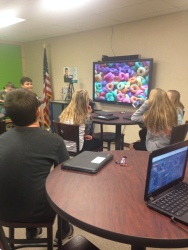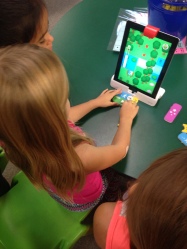by Dr. Lynn Brown, Dave Lockstein, and Aggie Salter
Montello is not waiting for the future. Our students are creating their future opportunities by learning Computer Science K – 6, including digital citizenship and coding. With a tremendous shift in our teaching practices in the past couple of years, our staff is intentionally connecting the school experience with life beyond the classroom. More importantly, our Board, community, and staff share a fundamental belief about the importance of the ever changing landscape of technology and its partnership with curriculum for our students future. Today is never tomorrow. Nothing stays the same. Alec Ross, former Director of Technology at the State Department, said, “If big data, genomics, cyber, and robotics are among the high-growth industries of the future, then the people who will make their livings in those industries need to be fluent in the coding languages behind them.” In Montello, coding begins in kindergarten. Yes, our kindergarteners are coding.
Montello boasts a 17 year Montello School District (MSD) veteran music teacher and Certified Google Educator and Trainer. She was passionate about using technology in her elementary music classroom to create greater engagement, achieve music standards, and ultimately have students take more ownership of their own learning. Piloting Quincy Jones’ Playground Sessions and creating her own online curriculum, it was then that this teacher realized her students’ quick acquisition of grade level standards using technology and their thirst for continued learning. Four years ago she offered the Hour of Code as an optional activity during lunch for fifth graders. “The Hour of Code is a global movement reaching over 100 million students in more than 180 countries.” (https://code.org/learn). This teacher and the fifth-grade teachers had no idea who would show up, and much to their surprise, every single 5th grade student came during their lunch! The following year, volunteer middle and high school students were trained to assist fellow students. From 2013-14 through 2015-16, Hour of Code was offered to grades four and five in their classrooms and grades seven and eight during their lunchtime. Not surprised, there was 100% participation.
In August 2014, MSD hired a new Director of Technology (DOT) who articulated a vision to change the way our teachers taught, our students learned, and the way technology was viewed. He believed technology would help shape curriculum from the foundation up; eventually becoming invisible when standardized in all aspects of education. We realized that the technology skills of both the DOT and our music teacher/technology coach were two sides of the same coin. With his strengths in vision and infrastructure implementation and her skills in classroom technology integration and coaching, our action plan was formed into three distinct but connected components of today’s innovative Montello classrooms:
- Get devices in the hands of staff and students
- Change the role of the teacher to facilitator/partner in learning
- Provide real world applications and experiences so students are prepared to leave our school
- Get devices in the hands of staff and students
The DOT pushed his device neutral philosophy for every staff member and student. He didn’t care that Montello was a poor rural district in the the eyes of outsiders. Our new DOT brought a vision of evolution from digital obscurity to one-to-world. This meant access anytime, anywhere, on any device. With his eye on both efficiency and effectiveness, the District moved to GAFE (Google Apps for Education). Leases were replaced with economic options, the number of servers were reduced, hardware rotations were established, and equipment was standardized. The long-term technology budget was actually reduced! Within one year, Chromebooks were purchased for every middle and high school student. Redistributed equipment was given to elementary students who now had 2:1 access. In the fall of 2015, our district was 1:1 in grades K-12 with a planned dedicated rotation schedule for new hardware. With equipment in place, access throughout the day, and instructional tools available anywhere, anytime, it required us to change our classroom practice. By doing so, we found alternative resources and began to revolutionize how we delivered instruction.
- Change the role of the teacher to facilitator/partner in learning
Technology is a tool, not an end unto itself. The teacher’s role has certainly changed. He or she is a facilitator, a partner in learning, and no longer a sage on the stage. When our music teacher became half-time music teacher and half-time technology coach, she realized that in order to ignite long-lasting change, she needed to change teacher beliefs. Modeling new classroom tools, providing extended training opportunities and support alongside MSD classroom teachers, mindsets and practices began to shift. The result – increased engagement from both teachers and students, more timely feedback to individualize instruction, and greater student ownership for their learning. This year, she transitioned to our full-time Integration Technology Specialist (ITS). She supports the PK-12 staff in technology integration in their classrooms as well as provides Computer Science instruction to students in grades K – 6 making MSD’s footprint bigger as we prepare our students to compete in a global market economy.
- Provide real world applications and experiences so students are prepared to leave our school
The synergy of the abilities of our ITS and DOT, combined with the support from the Board and Administration and a staff eager to learn, has positioned Montello to more fully implement Academic and Career Planning. One of those vehicles is teaching Computer Science K – 6. The essential skills in those classes include innovation (collaboration, communication, creativity, and critical thinking), digital citizenship, and coding (Java and beginning implementation of C++, and C Sharp). Our ITS continually searches out-of-the-box possibilities, while learning alongside her students and staff, in order to enhance the education repertoire of all she serves. Also, those initial Hour of Code student volunteers later formed our Technology Expedition Team (TekEx), a group of students working under our school-to-work program who provide tech support on all levels – from customer service to hardware and software support. These opportunities are allowing them to gain certifications and experience needed to start a career in technology right out of high school.
We are only in year three of a multi-year initiative that increases our students experiences, exposures, and skill sets to the world beyond Montello. Yet, in the midst of these adaptive shifts, MSD staff never forget that relationships and connections with students and each other are the single most important aspect to deepen our learning. “We have to make a connection to the heart before we can make connections to the brain,” says our ITS. In Montello, we believe each child regardless of age should go as fast as the student needs/wants to learn, with standards to help guide that process, and technology should help foster that growth. It should create engagement and a connection to the outside world – ensuring that they are prepared to leave our learning community. Montello stakeholders are increasing their global footprint in the hopes of our students’ and community’s greater contribution to mankind. Let’s find our collective voice to prepare our children for an ever changing world. MSD bears testimony that even small rural districts can teach computer science and begin in kindergarten, yes in kindergarten!


